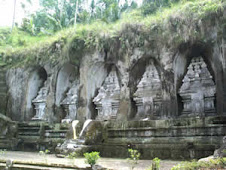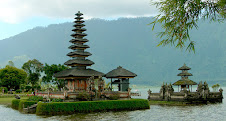7 Amazing Types of Bali Handicrafts
There are various kinds of Bali handicrafts which have become famous
nowadays as export products or souvenirs. Entire villages, especially in
Central Bali are dedicated to one specific craftsmanship such as
painting, mask carving, stone sculpting, batik or silver jewelry.
The Balinese people are a very creative kind of people and it seems they can make anything that comes to mind.
For centuries they are trained in making the most beautiful pieces of
Bali handicrafts for the temples and palaces of their kings.
Their skills are inherited through family traditions and throughout the years taken to an amazing level.
Now they still produce various types of art for temples but most of
them focus on the export since they can make a lot more money with this
trade.
Here are a couple of villages, which I think are worth visiting when
you are looking for that special piece of painting, silver jewelry or
statue...
 Bali Masks:
Bali Masks:
When I stop in the Balinese village of Mas on the way from Denpasar
to Ubud I’m always surprised to see how talented the Balinese are.
The woodcarving pieces are amazing especially the Balinese.
Not only are the masks an amazing sight, but each one of them have their own story to tell...
 Bali Statue:
Bali Statue:
If you need huge Buddha's, horses, Hindu depictions, life-sized
Indians or Hawaiian Tikis then the village of Batubulan just north of
Denpasar is the place to go.
Here the art of carving statues has reached a very high level even
though they were originally carved for decorating thousands of temples
on the island...
 Bali Paintings:
Bali Paintings:
The Balinese were not familiar with the word ‘art’ or ‘artist’ since they had never considered it to be art.
For them it was part of daily religious life, just like working in
the rice fields. This changed when foreigners arrived in the 1920's
and the Balinese adopted new painting techniques resulting into amazing
pieces of art...
 Bali Batik:
Bali Batik:
This is one of Indonesia's most famous and complicated traditional art form of all the Bali Handicrafts.
It's a technique that applies patterns of different colours to cloth
by dyeing in several stages and by applying wax after each stage to
protect areas of unwanted colour.
 Bali Textile
Bali Textile:
The best Bali sarongs are from the town of Blaju, Tenganan and Gianyar.
In Gianyar there's a textile factory where you can observe the
natural dyeing process, hand weaving and learn how raw cotton becomes
hand spun thread. A sarong might come in handy when you visit any of
Bali's famous temples...
 Gold and silver
Gold and silver:
Celuk, just north of Denpasar is the place to be if you're interested in the Bali handicrafts of gold or silver.
Traditionally this village has been the place where gold and silver
smiths work with precision on the finest jewelry available on the
island. Here also counts that the best deals are to be had in the alleys
and the back roads...
 Wayang Kulit:
Wayang Kulit:
This mystical and playful form of art involves two dimensional shadow
puppets that have entertained the people in Indonesia for generations.
Once placed between the white screen and oil lamp the puppets become alive...
When I find more of these villages where you can find beautiful
hand-made pieces of art I'll try to let you know as soon as possible so
you can have a look yourself and dive into all the Bali handicrafts on
display…
















 Barong Keris Dance Types
Barong Keris Dance Types Even though Barong Ket now often
performed as tourist attraction, it still considered as sacred dance.
The sanctity of Barong Ket started from the very beginning. From
selecting the proper wood for its mask, choosing the right day to
coloring the mask, creating the framework, selecting the feather and
even choosing the performer.
Even though Barong Ket now often
performed as tourist attraction, it still considered as sacred dance.
The sanctity of Barong Ket started from the very beginning. From
selecting the proper wood for its mask, choosing the right day to
coloring the mask, creating the framework, selecting the feather and
even choosing the performer.






 Ngaben
is one of Hindu’s great ceremony in Bali where the corpse is burnt,
accompanied by holly songs and offerings. Hindu’s believe that ngaben
will return the soul of a dead person to their abode in heaven or send
the dead through a transition to his next life. Ngaben is also a form of
a respect to their parents by releasing the soul from worldly
attachment. Families that conduct ngaben ceremony generally try not to
cry at the grave yard since they believe that tears would only incommode
the deceased journey to their eternal abode.
Ngaben
is one of Hindu’s great ceremony in Bali where the corpse is burnt,
accompanied by holly songs and offerings. Hindu’s believe that ngaben
will return the soul of a dead person to their abode in heaven or send
the dead through a transition to his next life. Ngaben is also a form of
a respect to their parents by releasing the soul from worldly
attachment. Families that conduct ngaben ceremony generally try not to
cry at the grave yard since they believe that tears would only incommode
the deceased journey to their eternal abode. Few
days before the climax ceremony, the family would consult the “dewasa”
(good day) to a priest to determine the proper day to conduct this
ceremony. The process began by built a stage as a place for nyiramin
(bathing the corpse), made a lembu (a buffalo shaped sarcophagus where
the corpse will be put into and burnt) and wadah (temple structure made
of paper, bamboo and light wood). This lembu will be carried to the
village grave yard in a procession.
Few
days before the climax ceremony, the family would consult the “dewasa”
(good day) to a priest to determine the proper day to conduct this
ceremony. The process began by built a stage as a place for nyiramin
(bathing the corpse), made a lembu (a buffalo shaped sarcophagus where
the corpse will be put into and burnt) and wadah (temple structure made
of paper, bamboo and light wood). This lembu will be carried to the
village grave yard in a procession. Hindus
have a purpose in life called the Artha Purusa Catur Dharma, Artha,
Kama and Moksha. This can not be realized at once but gradually.
Hindus
have a purpose in life called the Artha Purusa Catur Dharma, Artha,
Kama and Moksha. This can not be realized at once but gradually.  Purify Self
Purify Self 